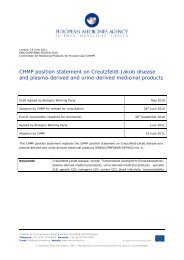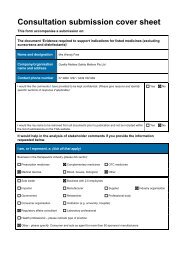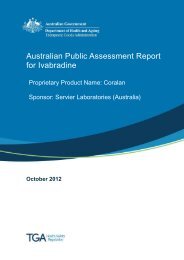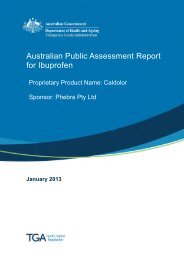<strong>Therapeutic</strong> <strong>Goods</strong> <strong>Administration</strong>measurements, however plasma concentrations were often below the limit ofquantification for many samples in all species and studies evaluated. Therefore, most ofthe PK studies were of limited value except to demonstrate minimal systemic exposure.Studies conducted or commissioned by the applicant were limited to:• Three Good Laboratory Practice (GLP) compliant in vitro human skin penetrationstudies comparing sponsor CP (lipocream, lotion and/or shampoo (Clobex); 0.05% CPw/w) formulations with commercial Temovate (cream, emollient cream or scalp(0.05% CP w/w)) formulations.• A GLP compliant in vivo rat study comparing the skin absorption of the proposed CPShampoo (Clobex; 0.05% CP w/w) with a commercial scalp formulation (DermovateScalp; 0.05% w/w).Limited PK information was also provided by a small number of literature references andpublished reports provided in summary form.After application to human skin in vitro for 16 hours, all CP formulations were primarilyrecovered in the epidermis, followed by a small amount in the dermis and almost nodetectable levels in the liquid receptor. While the CP shampoo had higher absorption levels(19% of the applied dose) than other formulations after the 16 hour exposure period, it isnoted that after 15 minutes exposure (proposed application period), the total applied doserecovered in the skin was 0.1% (epidermis only). These results were consistent with otherliterature data showing limited penetration of CP into the epidermis in vitro after 72 hourexposure. Thus, only very limited systemic exposure to CP is expected following topicalapplication as proposed clinically.Plasma CP concentrations were quantifiable following a single (10 hour) topicalapplication of Dermovate scalp formulation to rats. In contrast, after application of CPshampoo for 15 or 30 minutes most of the samples had CP concentrations below theLower limit of quantification (LoQ). Nonetheless, plasma levels following application ofeither substance showed a rapid absorption (time to peak plasma concentration (T max)=0.5-1 hour) profile, with peak plasma concentrations (C max) values of 0.9 and 0.4 ng/mL forCP shampoo after 15 and 30 minutes exposure, respectively and 2.8 ng/mL for Dermovatescalp lotion. After 48 hours, plasma levels were low for both formulations. The area underthe plasma concentration time curve between 0 h and 48 h (AUC 0-48h) determined forDermovate scalp formulation (45 ng.h/mL) was around 3 times higher than themaximised AUC 0-48h value (14-15 ng.h/mL) for CP shampoo. Thus, systemic CP absorptionin rats after topical application of CP shampoo was lower than that obtained for acommercial CP scalp lotion.Additional studies in rats demonstrated that occlusion of the treatment site significantlyincreased CP absorption irrespective of the vehicle or formulation used. Moreover, the CPplasma profile following SC administration displayed a more rapid absorption (T max = 4hours) and elimination (t 1/2 = 9 hours) compared to the dermal route (T max = 8 hours;levels remained high at 96 hours).No protein binding studies were submitted. However, given the low systemic exposureachieved in all toxicology studies, any concentration or species related differences in freeCP are likely to be negligible. A single tissue distribution study in rats given radiolabelledCP by the SC route demonstrated high radioactivity levels in the liver, gastrointestinal (GI)tract, kidneys, adrenals, pituitary, thyroid, prostate and fat, which decreased over time in amanner similar to levels in plasma.The metabolism of CP was not characterised in any nonclinical species; however, themetabolic profile is anticipated to follow that of other systemically administeredcorticosteroids. Consistent with the expected metabolic profile, CP was primarily excretedin the faeces (4-5 times the urine excretion levels) following SC and dermal administration<strong>AusPAR</strong> Clobex clobetasol <strong>propionate</strong> Galderma Australia Pty Ltd PM-2011-01596-3-5Final 22 May 2013Page 14 of 45
<strong>Therapeutic</strong> <strong>Goods</strong> <strong>Administration</strong>to rats. While dermal application of 0.05% CP was found to induce the drug metabolisingenzyme CYP1A-mediated ethoxycoumarin-0-dealkylase activity in the skin 5 fold, nopharmacokinetic drug interaction studies were conducted.Overall, these limited studies suggested minimal systemic exposure to CP followingdermal application of CP spray or shampoo when applied as proposed. However, it shouldbe noted that these studies were conducted in normal (intact) rather than psoriatic skin.Skin penetration rates are dependent on many factors including the surface area, to whichthe product is applied, the anatomical site exposed, the integrity of the skin; whether thevehicle of the formulation is oil or water based and whether the steroid is applied underocclusion. Therefore, it is likely that penetration and absorption rates are underestimatedin these studies.ToxicologyAcute toxicityNo acute toxicity studies were performed with the proposed CP 0.05% w/w shampooformulation. Kuramoto et al. (1975a) 5 showed that the acute oral toxicity of CP was low,with no mortality at up to 3 g/kg orally (PO) in mice and rats. However, mortalities wereobserved in both species following SC or IP administration with 50% lethal dose (LD 50)values of 82-156 mg/kg in mice and 351-414 mg/kg in rats. No IV toxicity studies werereported. However, acute studies conducted using several routes demonstrated adequateCP exposure with mortalities, clinical signs of toxicity and target organ toxicities (thymus,spleen, adrenals, kidney, liver, reproductive organs) in both species.Repeat-dose toxicityThe local and systemic repeat-dose toxicity of CP was mainly examined in rats (≤6months) and mini- or micropigs (≤9 months). A 3 month dose-range finding study and 9month photocarcinogenicity study was performed in mice, but only limited toxicologicalmeasurements were undertaken in these studies.Mice and rats are acceptable standard rodent species used for toxicity testing whilstminipigs were chosen as an appropriate non-rodent species given their similar skinhistology to humans.Sponsor studies conducted with the proposed CP shampoo were performed in minipigs(≤3 months) topically exposed for 15 minutes once daily followed by rinsing, as proposedclinically.Additional literature or sponsor studies used CP lotion, ointment or cream in mice (≤3months topical; dose-range finding) and rats (≤3 months topical; ≤6 months SC).All pivotal studies were GLP compliant (with the exception of the published 6 month SCstudy in rats) and generally employed adequate animal numbers and appropriate doseranges (usually up to dose-limiting toxicity). The duration of the toxicity studies (6 monthsin rats, 9 months in minipigs) was sufficient to support the maximum proposed clinicalduration (maximum of 4 weeks; with a possibility of retreatment) for the CP shampooformulation.5 Kuramoto M, Ishimura Y, Morimoto J, Lee S-Y, Okubo T. Study on the toxicity of clobetasol 17-<strong>propionate</strong> 1 - Acute toxicity by oral, subcutaneous and intraperitoneal applications and subacute andchronic toxicities by subcutaneous successive applications in rats. Shikoku Acta Medica, 31 (6), 377-398,1975.<strong>AusPAR</strong> Clobex clobetasol <strong>propionate</strong> Galderma Australia Pty Ltd PM-2011-01596-3-5Final 22 May 2013Page 15 of 45
















